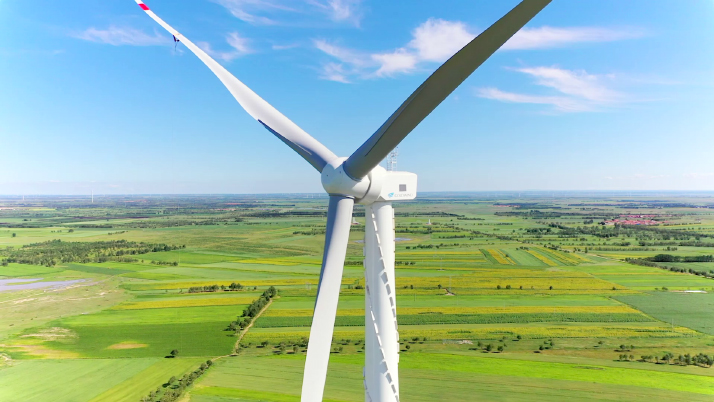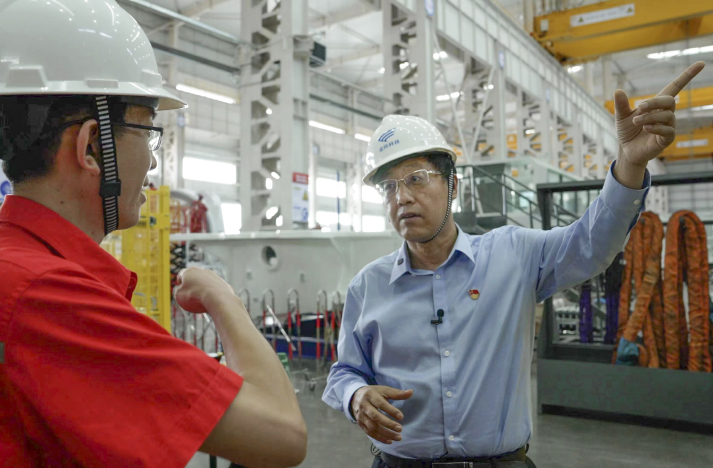| China |
| A wind energy expert devoted to powering industrial growth | |
|
|
 A Xinjiang Goldwind Science and Technology Co. Ltd.-equipped wind power project in Zhangjiakou, Hebei Province (COURTESY PHOTO)
The high-speed winds blowing through Xinjiang Uygur Autonomous Region once only whipped up dust and sand from the northwestern Chinese region's vast expanses of Gobi Desert, affecting local life and production. Today, hundreds of wind turbines transform these gusts into electricity, empowering the region and beyond in a modern green way. Wu Gang, Chairman of Xinjiang Goldwind Science and Technology Co. Ltd., has witnessed and contributed to this revolution. Wu, an industry veteran, was also a delegate to the 20th Communist Party of China National Congress taking place from October 16 to 22. During the congress, he proposed to further ensure China's energy security and improve innovation in the wind power industry. Looking back, Wu can still recall a time when he and his partners would have to master different electricity and machinery techniques all by themselves and go out into the field to conduct wind turbine testing. The development of Goldwind echoes the growth of China's wind power industry. Today, the company, with a global installed capacity of more than 89 GW, is China's largest wind turbine manufacturer and ranks second only to Denmark's Vestas worldwide. The company's products are sold across 38 countries, including many participants of the Belt and Road Initiative, a China-proposed initiative that aims to boost connectivity along and beyond the ancient Silk Road routes. "China's wind power industry once failed to keep up with its international peers. But China-built wind turbines have now gone global," Wu told Beijing Review. Taking off In 1987, Wu quit his job as a college lecturer in Xinjiang and became chief of the Dabancheng Wind Farm located some 50 km from the regional capital of Urumqi. At that time, the wind farm was merely a field for testing new technologies as China's wind energy industry had only just started to take shape. In the 1980s, the country was not yet able to carry out large-scale wind turbine installation. China built its first wind farm in 1986 by importing turbines from Denmark to address problems stemming from limited power resources. The industry was trapped by a lack of self-developed technologies. "Back then, we could only execute such a project through international cooperation," Wu explained. According to Wu, their major undertaking was to ensure the sound operation of all facilities, while harsh winds, sometimes blowing at a speed of 10 on the Beaufort wind scale—meaning a storm or whole gale, would affect the operation of turbines. All wind turbines have a maximum wind speed above which they cannot operate, this is called the turbine's "furling speed." If the wind speed exceeds the furling speed (for example in a storm), the turbine must be shut down to prevent the blades from getting damaged. When faced with turbines breaking down, Wu and his team often felt at a loss. As wind turbines were involved in government-backed technological research plans, China's wind power industry started taking off in the 1990s. With the determination to produce the necessary equipment in China, Wu and his partners established a company, Goldwind's predecessor, in 1998 and embarked on independent research and development (R&D). Their efforts soon increased the proportion of a 600-kW wind turbine's made-in-China components from 33.4 to 78 percent. This type of wind turbine went into operation at Dabancheng Wind Farm by late 1998. As more self-developed turbines came into being, the wind farm became the largest of its kind in China and Asia at that time. Today, it has a total installed capacity of 125 MW. The company took the name Goldwind in 2001. In 2005, it produced the first homegrown 1.2-MW wind turbine, proving it had made its way out of the technological shadows and onto the international stage. The company has since continued to introduce its self-developed R&D results. Wu has also focused much on green production within the company. As the wind power industry booms, recycling of solid waste is becoming a concerning issue. Data from Goldwind showed that China's retired turbine blades will generate 5,800 tons of composite solid waste by 2025, and 74,000 tons by 2028. In January 2021, the China Beijing Environmental Exchange issued the country's first renewable energy carbon neutrality certificate to Goldwind's industrial park in Beijing. At the park, a set of flower beds using 3D printing technology was created earlier this year, printed from recycled turbine blades. Through 3D printing robots, the materials containing crushed blade particles are pre-formed, promising a solid waste recycling rate of more than 30 percent. Goldwind has provided its green solutions to a range of industries. The company cooperated with the Tianjin Port to launch the first zero-carbon terminal worldwide last year.  Wu Gang (right) talks with an engineer at the industrial base of Xinjiang Goldwind Science and Technology Co. Ltd. in Urumqi, Xinjiang Uygur Autonomous Region, on August 6 (XINHUA)
Green emergence The turbine industry used to be dominated by foreign manufacturers, including Vestas and American GE Wind Energy. With the emergence of Goldwind and other Chinese companies, China currently occupies more than two thirds of the global market share. According to the Global Wind Energy Council, Goldwind is the world's second largest global turbine supplier with 11.8 percent of new installations, right after Vestas with 17.7 percent in 2021. Out of the global top 10 wind turbine suppliers last year, six came from China. China's wind power industry has reached new heights in recent years. It is currently home to the world's largest offshore wind industry. In 2021, nationwide grid-connected wind power capacity exceeded 300 GW, the National Energy Administration said. "Through decades of efforts, China's wind power industry has seen improvements in R&D, and developed complete industrial systems," Wu said. The 21st century has witnessed the constant refinement of technological innovation in China's wind power. Since 2017, the industry has further advanced itself by incorporating new technologies like the Internet of Things, big data and artificial intelligence. Since wind resources can be inconsistent, wind turbines need constant monitoring and maintenance. "A decade ago, engineers had to physically travel to remote sites where wind turbines were installed to conduct checkups. Today, digital solutions allow them to monitor their turbines remotely, which has ensured sound operations and enhanced usage efficiency to 99.9 percent," Wu said. China is currently going through a key phase of energy transformation, during which it still largely relies on imported energy. Data from the National Bureau of Statistics showed that China's energy consumption reached 5.24 billion tons of standard coal equivalent in 2021. Last year, it imported 310 million tons of coal and 480 million tons of petroleum, both ranking first in the world. "China needs to promote the use of non-fossil fuels, especially wind power, to ensure the stability of industrial and supply chains and sustainable economic growth," Wu said. In his opinion, wind power backed by full-fledged technology is both flexible and cost-effective. It is expected to become a major power resource of China in the next 30 years. To better meet China's goals of peaking carbon emissions before 2030 and achieving carbon neutrality before 2060, energy enterprises need to improve their R&D capacities to create breakthroughs in core technologies and power other industries for green transformation, he said. (Print Edition Title: Gain With the Wind) Copyedited by Elsbeth van Paridon Comments to lixiaoyang@cicgamericas.com |
|
||||||||||||||||||||||||||||
|